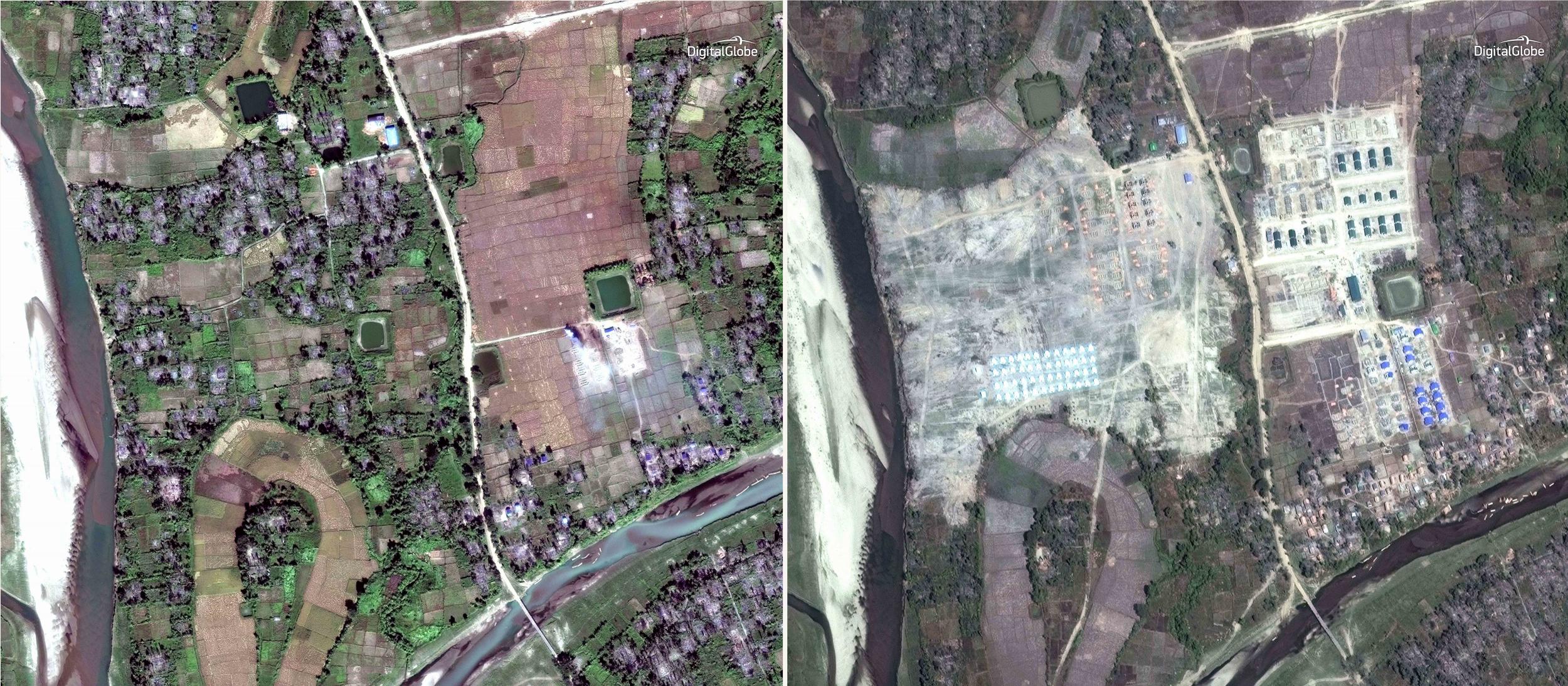Rohingya crisis: Satellite images 'show burned remains of bulldozed Muslim villages'
Authorities in Rakhine accused of building over evidence of mass murder, rape and looting, as well as preventing Rohingya from returning

Your support helps us to tell the story
From reproductive rights to climate change to Big Tech, The Independent is on the ground when the story is developing. Whether it's investigating the financials of Elon Musk's pro-Trump PAC or producing our latest documentary, 'The A Word', which shines a light on the American women fighting for reproductive rights, we know how important it is to parse out the facts from the messaging.
At such a critical moment in US history, we need reporters on the ground. Your donation allows us to keep sending journalists to speak to both sides of the story.
The Independent is trusted by Americans across the entire political spectrum. And unlike many other quality news outlets, we choose not to lock Americans out of our reporting and analysis with paywalls. We believe quality journalism should be available to everyone, paid for by those who can afford it.
Your support makes all the difference.New satellite pictures purport to show how the government of Myanmar is bulldozing the remains of villages that were burnt to the ground to drive out Rohingya Muslims.
The photographs are said to reveal that dozens of empty settlements have been destroyed – far more than previously believed.
Human rights groups say authorities are eliminating crucial evidence of the mass atrocities carried out against the ethnic Rohingya minority.
The villages in Rakhine state were set ablaze after violence erupted last summer, when security forces drove hundreds of thousands of Rohingya into exile, in a brutal clearance operation.
The government of Myanmar strongly denies any wrongdoing, saying its military operation in Rakhine is a proportionate response to “terrorist” groups operating in the region.
One woman said she was shocked by what she saw when she recently returned from Bangladesh to her old home in Myin Hlut. Most houses had been torched last year, but now, “everything is gone, not even the trees are left,” said 18-year-old Zubairia. “They just bulldozed everything – I could hardly recognise it.”
She said other homes that had been abandoned but not initially damaged had now also been flattened. “All the memories that I had there are gone,” she told AP. “They’ve been erased.”
The crisis in Rakhine state began in August after Rohingya insurgents launched a string of unprecedented attacks on security posts.
Myanmar’s armed forces are accused not just of burning Muslim villages with the help of Buddhist mobs, but also of massacres, rapes and widespread looting.
Campaigners say the government is wrecking scores of crime scenes before any investigation takes place, and the Rohingya believe it is a drive to destroy their culture to make it impossible for them to return.
The new aerial photographs show at least 28 villages or hamlets were bulldozed in a 30-mile radius around Maungdaw between December and February; on some of the cleared areas, construction crews had erected new housing and helipads.
Human Rights Watch says the number of villages wrecked is at least 55.
The images offer a window into what is effectively a part of Myanmar that is largely sealed off to the outside world. Myanmar bars independent media access to Rakhine state.
The government claims it is trying to rebuild a devastated region, and for months has been expanding roads, repairing bridges and constructing shelters, with a large transit camp at Taungpyo, near the Bangladesh border. The camp opened last month to house returning refugees, who have yet to arrive.
Myint Khine, a government administrator, said some of the new homes were intended for Muslims. But that does not appear to be the case so far, and many Rohingya fear authorities are seizing land they’ve lived on for generations.
A government list in December indicated 787 houses would be built, most for Buddhists or Hindus. Only 22 were slated for so-called “Bengalis” – the word Myanmar nationalists often use to describe the Rohingya, who they say are illegal migrants from Bangladesh.
Mr Khine said: “Of course we have been using machines like earth removers and bulldozers because we have to clear the ground first before building new houses.”
Chris Lewa, whose Arakan Project monitors the persecuted minority’s plight, said the destruction would make it even harder for the Rohingya, who have no citizenship and few rights, to ever reclaim their land.
“How will they identify where they lived, if nothing is left, if nothing can be recognised?” Mr Lewa said. “Their culture, their history, their past, their present – it’s all being erased. When you see the pictures, it’s clear that whatever was left – the mosques, the cemeteries, the homes – they’re gone.”
Richard Weir, a Myanmar expert with Human Rights Watch, said: “There’s no more landmarks, there’s no trees, there’s no vegetation.
“Everything is wiped away, and this is very concerning, because these are crime scenes. There’s been no credible investigation of these crimes. And so, what we’re talking about really is obstruction of justice.”
Mr Weir added: “We don’t know where all the graves are ... because there is no access.”
Additional reporting by AP
Join our commenting forum
Join thought-provoking conversations, follow other Independent readers and see their replies
Comments